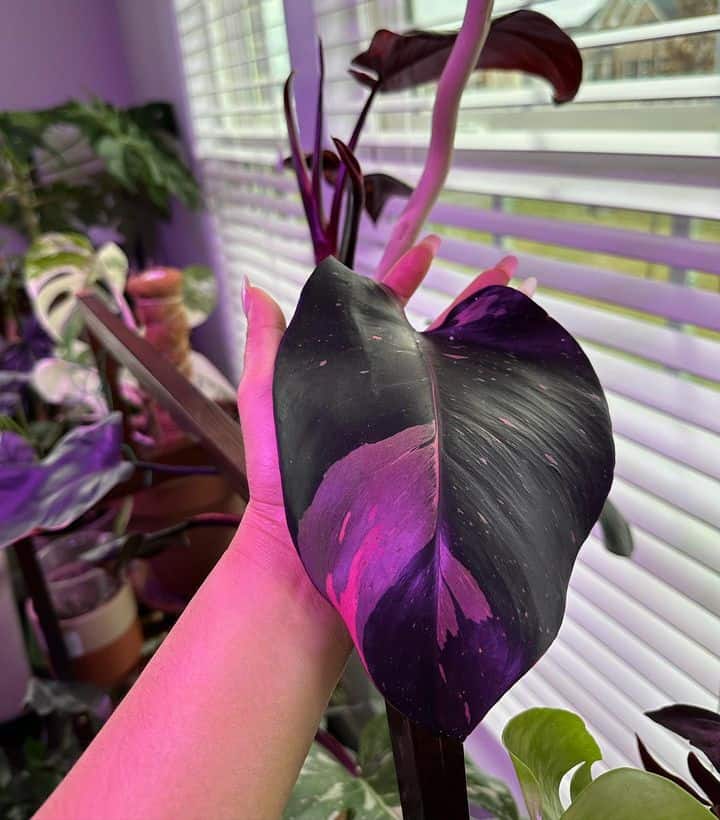With evergrowing demand, Pink Princess Philodendron has skyrocketing expensive prices but with reasonable backstory.
Therefore, the growers often demand high prices for their niche products from a handful of buyers, giving the plants royal status.
Read on to find out why they are so expensive, where to find one, and how to identify a fake.
Table of Contents Show
Was Pink Princess Philodendron Always Expensive?
Actually, Yes! Pink Princess Philodendron was consistently high in demand but less in supply, making them expensive.
Even if you find the cheap one from an online store, it would still not be pocket-friendly. To make things worse, it can be a scam.
A mature Pink Princess would start at over $100 and go up to almost $2,000.
This is why Pink Princess is so expensive yet in demand.
The plant is a status symbol among plant lovers, where one plant lover would envy another for owning a Pink Princess Philodendron.
How Did it Come to Be?
The mystery behind the unique variegation is in the plant DNA, which can not be replicated via adjusting lights or nutrients.
Despite being complicated and expensive, this method produces multiple Pink Princesses with perfect pink shade.
Due to the uncertainty of propagated plants turning full-fledged pink, it is hard to find one at a low price.

Therefore, a quarter to a third of propagated Pink Princess is thrown away for lacking visible signs of pinkness.
However, not all propagation methods fail when trying to reproduce multiple samples simultaneously.
What Makes Philodendron Pink Princess so Expensive?
It is likely that a grower significantly increases the price to cover the loss incurred on batches of unsold Pink Princess.
However, it is not the only reason these unusual plants are so expensive.
Here are a few reasons explaining why Pink Princess Philodendron is so expensive.
1. Lab-Grown Product
Much to our surprise, Pink Princess Philodendron does not exist in nature.
Instead, Pink Princess was initially grown in the lab by combining tissues from different Philodendron mother plants.
They are grown as unique Philodendron sub-species that mimic the exact qualities of a tropical plant.
Therefore, it is relatively impossible to determine whether the cuttings are from an original plant or early tissue culture.
Moreover, a plant with perfect pink variegation is harder to make even in lab-grown conditions, making them a rarity.
2. Variegations of Leaves
The unique pink variegation of leaves is one reason that makes Pink Princess Philodendron so expensive.
Although some people do not find variegation that special, many plant lovers find it amusing and unique.
In the case of Pink Princess, it is the perfect shade of color pink distinct from the green part of the leaf that makes it stand out.
However, variegation is very rare to get in Pink Princess Philodendron. In the figures, the likelihood of producing variegation is about 1:100,000.
3. Increase in Demand
Thanks to social media influencers, there was a surge in demand for Pink Princess Philodendron.
They became an instant obsession. With rapid publicity via social platforms, it only went uphill.
Despite the skyrocketing demands, the product availability was scarce, making Pink Princess Philodendron ever so expensive.
How to Identify a Fake Pink Princess Philodendron?
Do not be alarmed when you find a Pink Princess Philodendron advertised for a way lower price on many websites and social media sites.
Although not precisely a fake, it is a Philodendron plant native to Congo.

Unlike Pink Princess, its leaves are not naturally variegated but chemically modified to produce a temporary green color.
Here are some tell-tale signs to identify a Pink Congo.
- Pointier leaves
- Green leaves on the bottom with pink leaves on the top
- Full pink shade instead of variegation
- The small size of the plant
- Pink Congo leaves revert to green color after 12 months of purchasing.
Pink Congo is modified using the Auxin chemical that stimulates ethylene production.
However, the leaves will lose their pink shade over time, turning them green.
Where to Buy Pink Princess Philodendron?
Many online vendors claim to have genuine Pink Princess Philodendrons for sale.
But beware of scammers with fake advertisements and unreasonably high prices.
Here are a few reliable, verified online retailers with Pink Princess Philodendron for sale.
| Sellers | Shipping Details |
|---|---|
| Garden Goods | 3 to 5 business days |
| Aroid Market | Within 2 to 3 weeks |
| Steves Leaves | Within a week |
| Etsy | 2 to 3 business days |
| PLNTs | Ships right after order placement |
Tips to Care Pink Princess Philodendron
Once you successfully bring a plant fresh off the boat, care to provide it an optimum growing condition at all times
Here is a guide to help you understand your plant’s requirements.
- Bright, Indirect Lighting: Give them at least 6-8 hours of sunlight by placing them next to the south window protected from direct sunlight.
- Warm Temperature: Maintain temperature a 65-79°F (18-26°C) and do not let it dip below 60°F.
- Appropriate Watering: Water when the top 2 inches of the soil dry out or aim for 7-10 days rule in the active season but once a month in winter.
- High Humidity: Ensure optimal humidity of 65-75% for optimal foliage growth using a humidifier.
- Regular Fertilizing: Provide a balanced 20-20-20 fertilizer every 3-4 weeks from spring to summer.
- Control Pests: They are prone to mealybugs, aphids, spider mites, scale, and fungus gnats. Thus, regularly inspect and apply neem oil.
- Control Diseases: Overwatering can invite severe root rot, rust spots, and fungal infections. So, watch out for them.
Wrapping Up…
Pink Princess Philodendron is not as rare as it used to be, and the price is lowering. Even then, they are more expensive than other Philodendrons.
But do not trust every Pink Princess Philodendron you see online, as numerous scammers exist. Check the seller’s credibility with customers’ reviews so you won’t get scammed.
Good Luck!


